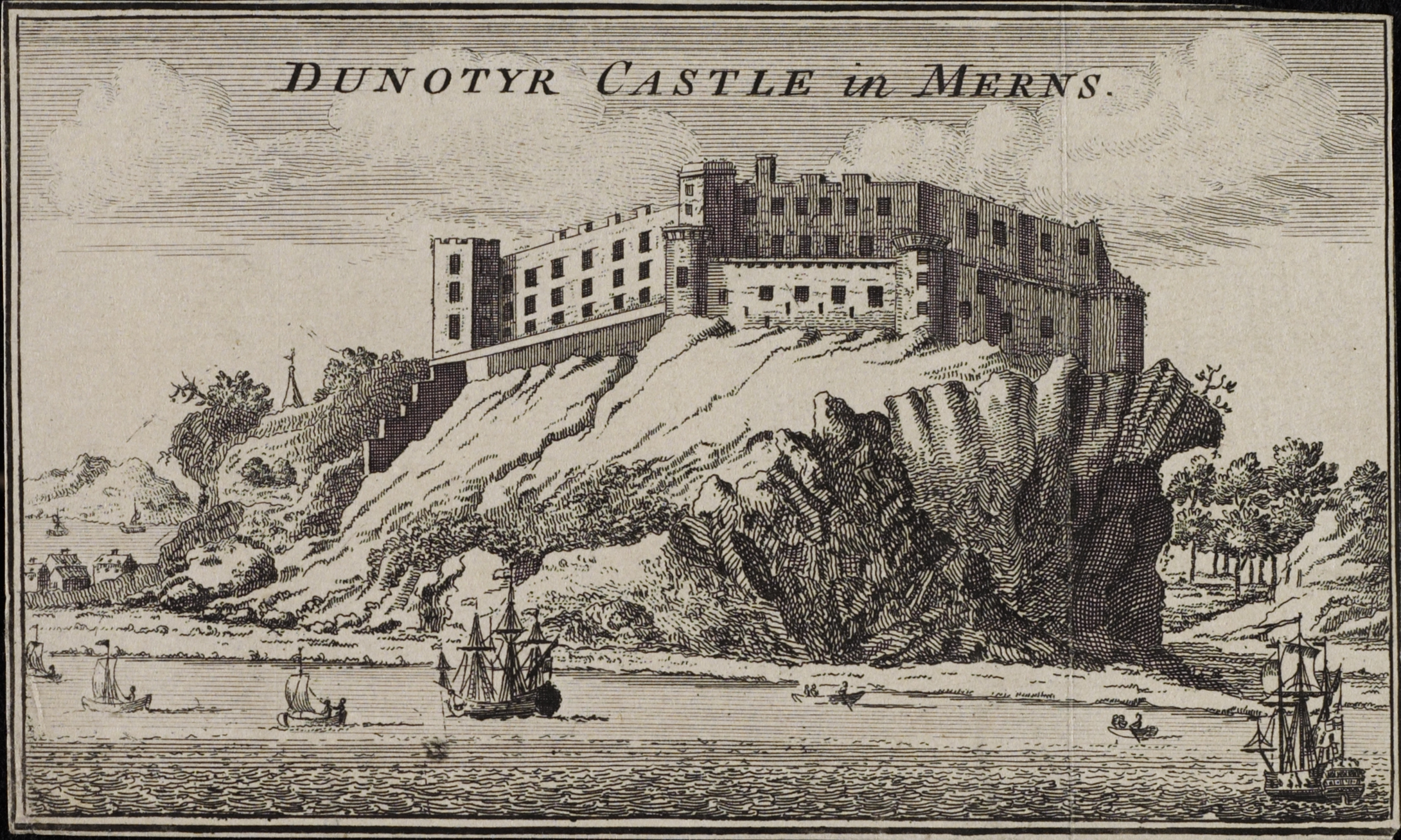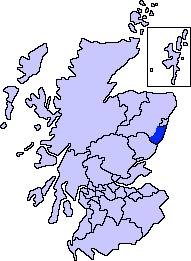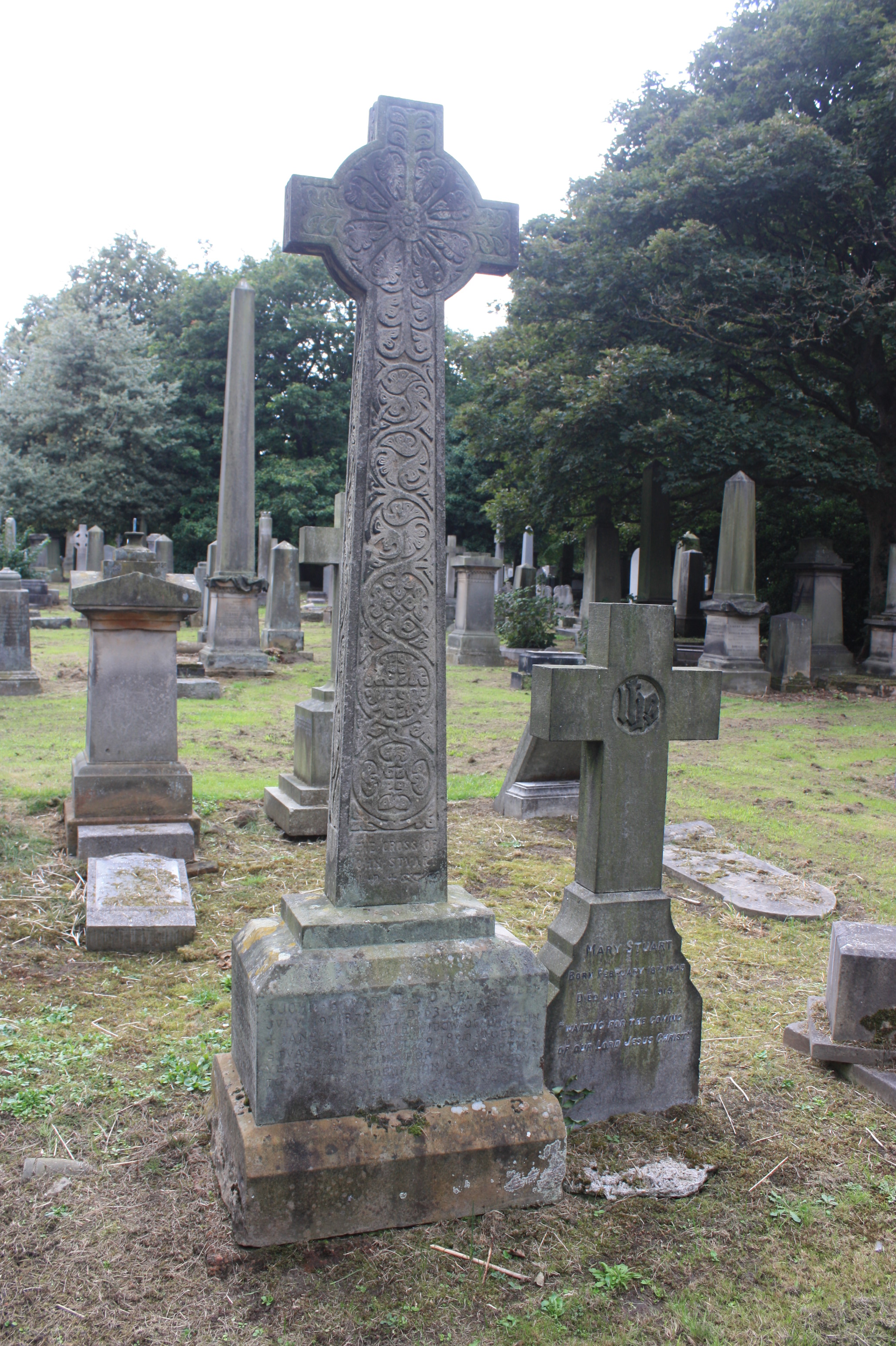|
Dunnicaer
Dunnicaer, or Dun-na-caer, is a precipitous sea stack just off the coast of Aberdeenshire, Scotland, between Dunnottar Castle and Stonehaven. Despite the unusual difficulty of access, in 1832 Pictish symbol stones were found on the summit and 21st-century archaeology has discovered evidence of a Pictish hill fort which may have incorporated the stones in its structure. The stones may have been incised in the third or fourth centuries AD but this goes against the general archaeological view that the simplest and earliest ( Class I) symbol stones date from the fifth or even seventh century AD. Sea stack Sited between Stonehaven and the similarly situated Dunnottar Castle, the sea stack is in Strathlethan Bay, with Downie Point to the north and just offshore from the cliffs at Bowdun Head to the south. It is cut off from the mainland at high tide and the flat, grassy summit is entirely surrounded by precipitous cliffs some high. The conglomerate rock is lower Old Red Sandstone ... [...More Info...] [...Related Items...] OR: [Wikipedia] [Google] [Baidu] |
Dunnicaer (geograph 5340586)
Dunnicaer, or Dun-na-caer, is a precipitous sea stack just off the coast of Aberdeenshire, Scotland, between Dunnottar Castle and Stonehaven. Despite the unusual difficulty of access, in 1832 Pictish symbol stones were found on the summit and 21st-century archaeology has discovered evidence of a Pictish hill fort which may have incorporated the stones in its structure. The stones may have been incised in the third or fourth centuries AD but this goes against the general archaeological view that the simplest and earliest ( Class I) symbol stones date from the fifth or even seventh century AD. Sea stack Sited between Stonehaven and the similarly situated Dunnottar Castle, the sea stack is in Strathlethan Bay, with Downie Point to the north and just offshore from the cliffs at Bowdun Head to the south. It is cut off from the mainland at high tide and the flat, grassy summit is entirely surrounded by precipitous cliffs some high. The conglomerate rock is lower Old Red Sandstone. ... [...More Info...] [...Related Items...] OR: [Wikipedia] [Google] [Baidu] |
Dunnicaer Hill Fort Excavated 2015
Dunnicaer, or Dun-na-caer, is a precipitous sea stack just off the coast of Aberdeenshire, Scotland, between Dunnottar Castle and Stonehaven. Despite the unusual difficulty of access, in 1832 Pictish symbol stones were found on the summit and 21st-century archaeology has discovered evidence of a Pictish hill fort which may have incorporated the stones in its structure. The stones may have been incised in the third or fourth centuries AD but this goes against the general archaeological view that the simplest and earliest ( Class I) symbol stones date from the fifth or even seventh century AD. Sea stack Sited between Stonehaven and the similarly situated Dunnottar Castle, the sea stack is in Strathlethan Bay, with Downie Point to the north and just offshore from the cliffs at Bowdun Head to the south. It is cut off from the mainland at high tide and the flat, grassy summit is entirely surrounded by precipitous cliffs some high. The conglomerate rock is lower Old Red Sandstone. ... [...More Info...] [...Related Items...] OR: [Wikipedia] [Google] [Baidu] |
Strathlethan Bay
Strathlethan Bay is on the North Sea The North Sea lies between Great Britain, Norway, Denmark, Germany, the Netherlands and Belgium. An epeiric sea on the European continental shelf, it connects to the Atlantic Ocean through the English Channel in the south and the Norwegian S ... coast of Aberdeenshire, Scotland just south of Stonehaven. To the north is Downie Point near which lies Stonehaven's Black Hill war memorial – the popular walk from Stonehaven to Dunnottar Castle runs along this part of the trail. On the other side of the bay is Dunnicaer, an inaccessible sea stack just offshore of Bowdun Head. The long-distance Aberdeenshire Coastal Trail runs around the bay at the top of steep cliffs. On 19 November 1916 the wreckage of the Norwegian steamer ''Isa Fiord'' (meaning ice fiord) was washed ashore in the bay and on 8 October 1940 the Danish ship ''Bellona II'' came aground after it had suffered bombing damage off Gourdon, Aberdeenshire, Gourdon. References [...More Info...] [...Related Items...] OR: [Wikipedia] [Google] [Baidu] |
Dunnottar Castle
Dunnottar Castle ( gd, Dùn Fhoithear, "fort on the shelving slope") is a ruined medieval fortress located upon a rocky headland on the north-eastern coast of Scotland, about south of Stonehaven. The surviving buildings are largely of the 15th and 16th centuries, but the site is believed to have been fortified in the Early Middle Ages. Dunnottar has played a prominent role in the history of Scotland through to the 18th-century Jacobite risings because of its strategic location and defensive strength. Dunnottar is best known as the place where the Honours of Scotland, the Scottish crown jewels, were hidden from Oliver Cromwell's invading army in the 17th century. The property of the Keiths from the 14th century, and the seat of the Earl Marischal, Dunnottar declined after the last Earl forfeited his titles by taking part in the Jacobite rebellion of 1715. The castle was restored in the 20th century and is now open to the public. The ruins of the castle are spread over , su ... [...More Info...] [...Related Items...] OR: [Wikipedia] [Google] [Baidu] |
Kincardine And Mearns
Kincardine and Mearns is one of six area committees of the Aberdeenshire council area in Scotland. It has a population of 38,506 (2001 Census). There are significant natural features in this district including rivers, forests, mountains and bogs (known locally as ''mosses''). Transport links with Aberdeen have encouraged rapid population growth, especially in the north of this region. Existing settlements such as Portlethen and Stonehaven have greatly expanded, along with industrial activity. The southern part is more self-sufficient, with the fertile Mearns area sustaining a strong agricultural economy. Small scale tourism activity occurs along its attractive coastline and former fishing villages. Kincardine and Deeside district Between 1975 and 1996 Kincardine and Deeside was a local government district within the Grampian region. Its area included all of the county of Kincardineshire apart from a small area in the northeast which was covered by the City of Aberdeen. As the ... [...More Info...] [...Related Items...] OR: [Wikipedia] [Google] [Baidu] |
Bowdun Head
Bowdun Head is a headland landform on the North Sea coast approximately one kilometre south of Stonehaven, Scotland.(Ordnance Survey, 2004) Slightly to the north is another headland, Downie Point. Somewhat to the south along the coast is Dunnottar Castle on the far side of the bay of Castle Haven. Other historic structures in the general vicinity include the Stonehaven Tolbooth, Fetteresso Castle, the Chapel of St. Mary and St. Nathalan and Muchalls Castle. There is considerable prehistory associated with the local area including a Pictish hill fort on the sea stack of Dunnicaer immediately to the north, and Bronze Age archaeological sites at Fetteresso (Hogan, 2008) and Spurryhillock, both somewhat inland of Bowdun Head. See also *Fowlsheugh References *Ordnance Survey , nativename_a = , nativename_r = , logo = Ordnance Survey 2015 Logo.svg , logo_width = 240px , logo_caption = , seal = , seal_width = , seal_caption = , picture = , picture_width = , picture_capt ... [...More Info...] [...Related Items...] OR: [Wikipedia] [Google] [Baidu] |
Iona
Iona (; gd, Ì Chaluim Chille (IPA: �iːˈxaɫ̪ɯimˈçiʎə, sometimes simply ''Ì''; sco, Iona) is a small island in the Inner Hebrides, off the Ross of Mull on the western coast of Scotland. It is mainly known for Iona Abbey, though there are other buildings on the island. Iona Abbey was a centre of Gaelic monasticism for three centuries and is today known for its relative tranquility and natural environment. It is a tourist destination and a place for spiritual retreats. Its modern Scottish Gaelic name means "Iona of (Saint) Columba" (formerly anglicised as "Icolmkill"). In 2019, the island's estimated population was 120. Residents engage in farming, using traditional methods. Other occupations include crofting and tourism-related work; some craftsmen make goods for sale locally, such as pottery, tapestries, jewellery and knitted goods. In March 1980, the Hugh Fraser Foundation donated much of the main island (and its off-lying islands) to the current owner, the National ... [...More Info...] [...Related Items...] OR: [Wikipedia] [Google] [Baidu] |
Canmore (database)
Canmore is an online database of information on over 320,000 archaeological sites, monuments, and buildings in Scotland. It was begun by the Royal Commission on the Ancient and Historical Monuments of Scotland. Historic Environment Scotland has maintained it since 2015. The Canmore database is part of the National Record of the Historic Environment (or NRHE), formerly the National Monuments Record of Scotland (or NMRS) and contains around 1.3 million catalogue entries. It includes marine monuments and designated official wreck sites (those that fall under the Protection of Wrecks Act The Protection of Wrecks Act 1973 (c. 33) is an Act of the Parliament of the United Kingdom which provides protection for designated shipwrecks. Section 1 of the act provides for wrecks to be designated because of historical, archaeological or ...), such as the wreck of . References External links * Archaeology of Scotland Architecture in Scotland Canmore Archives in Scotland Databas ... [...More Info...] [...Related Items...] OR: [Wikipedia] [Google] [Baidu] |
Archaeology Data Service
The Archaeology Data Service (ADS) is an open access digital archive for archaeological research outputs. It is located in The King's Manor, at the University of York. Originally intended to curate digital outputs from archaeological researchers based in the UK's Higher Education sector, the ADS also holds archive material created under the auspices of national and local government as well as in the commercial archaeology sector. The ADS carries out research, most of which focuses on resource discovery, cross-searching and interoperability with other relevant archives in the UK, Europe and the United States of America. The Archaeology Data Service is listed in the Registry of Research Data Repositories re3data.org. History In the late 1990s a consensus developed in the field of archaeology that archaeological data in digital form was highly fragile due to both an inadequate understanding of technical threats to its sustainability and the lack of an infrastructure to preserve it ... [...More Info...] [...Related Items...] OR: [Wikipedia] [Google] [Baidu] |
Spalding Club
The Spalding Club was the name of three successive antiquarian and text publication societies founded in Aberdeen, which published scholarly editions of texts and archaeological studies relevant to the history of Aberdeenshire and its region. The clubs were named after the 17th-century historian John Spalding. First club The original club was founded by Joseph Robertson (1810–1866) in 1839, and included among its members Cosmo Innes and John Stuart. Stuart served as secretary and was editor of many of the works published. Thirty-eight quarto volumes appeared in the club's main numbered series, as well as another six volumes uniform with but not part of that series. Seventeen of these volumes were edited by John Stuart: his more important works included ''Sculptured Stones of Scotland'' (1856 and 1867), a highly valued work of antiquarian reference; and '' The Book of Deer'' (1869), an edition of an important manuscript Gospel Book held at one time at the abbey of Deer. The cl ... [...More Info...] [...Related Items...] OR: [Wikipedia] [Google] [Baidu] |
John Stuart (genealogist)
John Stuart LLD (1813–1877) was a Scottish genealogist. Life Stuart was born in November 1813 at Forgue, Aberdeenshire, where his father had a small farm. He was educated at Aberdeen University, and in 1836 became a member of the Aberdeen Society of Advocates. In 1853 he was appointed one of the official searchers of records in the Register House, Edinburgh, and in 1873 became principal keeper of the register of deeds. In 1854 he was appointed secretary of the Society of Antiquaries of Scotland, and was central to its operation. In 1839, along with Joseph Robertson (1810–1866) and Cosmo Innes, he joined the 'Spalding Club,' of which he acted as secretary till the close of its operations in 1870. Of the thirty-eight quarto volumes issued by the club, fourteen were produced under Stuart's editorship. Prominent among these were the two large folios on ''The Sculptured Stones of Scotland,'' published in 1856 and 1867, and regarded by antiquarians as one of their most important ... [...More Info...] [...Related Items...] OR: [Wikipedia] [Google] [Baidu] |
Hadrian's Wall
Hadrian's Wall ( la, Vallum Aelium), also known as the Roman Wall, Picts' Wall, or ''Vallum Hadriani'' in Latin, is a former defensive fortification of the Roman province of Britannia, begun in AD 122 in the reign of the Emperor Hadrian. Running from Wallsend on the River Tyne in the east to Bowness-on-Solway in the west of what is now northern England, it was a stone wall with large ditches in front of it and behind it that crossed the whole width of the island. Soldiers were garrisoned along the line of the wall in large forts, smaller milecastles and intervening turrets. In addition to the wall's defensive military role, its gates may have been customs posts. A significant portion of the wall still stands and can be followed on foot along the adjoining Hadrian's Wall Path. The largest Roman archaeological feature in Britain, it runs a total of in northern England. Regarded as a British cultural icon, Hadrian's Wall is one of Britain's major ancient tourist attract ... [...More Info...] [...Related Items...] OR: [Wikipedia] [Google] [Baidu] |
.jpg)





